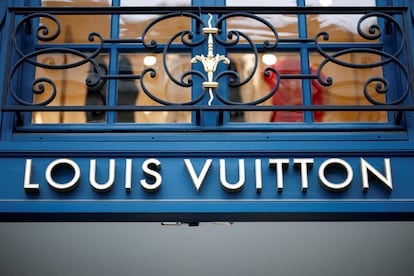The luxury sector is gearing up for a new earnings season: Here’s what to expect
Experts say that demand from China and the brands’ reception there will set the course for listed companies


The luxury sector is gearing up for a new earnings season. Far from the ostentation and extravagance of previous years, when the revenues of companies in this sector were experiencing strong growth, this time it is expected to be an austere first quarter that could well be called “the return to reality.” Louis Vuitton, the French luxury giant and the most valuable company in the world, will be in charge of kicking off the closing of the Parisian markets. After the profit warning and consequent plunge that Kering, which owns Gucci, took last month in the stock market, all eyes are on the imminent reporting of accounts. Bank of America analysts foresee a very polarized season in which it will be necessary to be selective when investing in the sector.
The U.S. bank’s experts expect the sector as a whole to see its revenues stagnate compared to their levels in the first quarter of 2023. A 0% performance may seem bad, but it is worth bearing in mind that in the first quarter of 2023 the firms’ combined revenues rebounded by 15% year-on-year, so the statistical effect is working against it this time. Despite this superficial flatness, there is significant movement deeper down.
“We expect 0% growth for the sector, but the gap between the best and the worst is going to be almost 40%. We are expecting -20% for Gucci and +17% for Brunello Cucinelli. The most decisive factor will be demand in China, where there are mixed readings of the situation. As a potential positive surprise, there could be a better-than-expected performance in the European market,” they say. With these mixed views on China, Bank of America refers to the fact that the Asian giant’s domestic market has not responded well at all, but Chinese buyers abroad and tourism have come back strong.
China is of vital importance for the luxury sector. How well brands are received there is the difference between a stock market plunge and a good performance. On March 20, Kering lost €7.6 billion ($8 billion) on the stock market in a single day due to Gucci’s weakness in the Chinese market. According to the Bank of America report, in the first quarter of 2023, the Asia-Pacific region contributed 44% of all global revenues in the sector. While Kering and Zegna have suffered there, Prada and Moncler have announced good performances. “We think there is going to be more polarization in each brand’s performance in this region. We think the aspirational luxury brands will suffer more, while the more powerful brands will benefit,” they predict.
Bank of America expects better revenues this earnings season for Brunello Cucinelli (+16.8% year-on-year), Hermes (+16%), Prada (+13.7%) and Moncler (+12%). In the case of LVMH, Bank of America forecasts a 3.3% increase in revenues. In contrast, it anticipates losses for Kering (-10.9%), Burberry (-14%), Ferragamo (-17%) and Gucci (-20.1%, as the Kering group indicated in its profit warning). “LVMH, Hermes and Brunello Cucinelli are our favorite sector picks, while we are cautious about Kering, Burberry and Ferragamo,” the analysts explain.
Looking at the 12-month price targets for the different companies, experts say that Hugo Boss (+47.8%), Hermes (+32.2%), LVMH (+28.1%), Pandora (+22.4%) and Brunello Cucinelli (+19%) are the most promising companies.
Citi generally agrees with the Bank of America’s forecast. Indeed, it is especially bullish about Hermes. According to a recent report, Citi analysts believe that Hermes has the potential to overtake LVMH in revenue in the coming years. They estimate that by 2027 or even earlier, Hermes will be making profits of €20 billion ($21.2 billion).
“Hermes has some of the most stable growth, margins and cash flows in the entire luxury industry,” says Thomas Chauvet, an analyst at Citi. The expert praises Hermes’ pricing strategy, which ranges from affordable to high-end luxury, the brand’s control over distribution, and the opportunities it has to grow beyond leather and handbags.
For her part, Caroline Reyl, lead manager of the Pictet Premium Brands fund, also thinks that polarization is going to be the dominant trend. “Last quarter’s earnings season for companies with high-end brands showed contrasts. In luxury, Ferrari, Hermès, Moncler and Brunello Cucinelli continued to benefit from customer loyalty, with no slowdown in demand. Other luxury brands with less exposure to the high-end and less consistent management — such as Kering and Burberry, which reduced forecasts for the coming quarters — have had a harder time,” she says.
On the transactions she has made ahead of the earnings season, Reyl speaks of a certain rotation. On the one hand, she has divested positions in some of the luxury hotel companies that were positioned for the good performance they have already had. In return, she has invested in new names in cosmetics. “We recently added Galderma, a leading supplier of dermatological cosmetics, which went public in a high-growth and profitable segment, with high-end brands such as Cetaphil, Restylane and Sculptra. We have also increased our stakes in Prada and Accor, as well as Estée Lauder. However, we have reduced shares in hotels after their very good performance and cut back on Visa, LVMH, Nike, L’Oréal, Burberry and Puma and in sports and spirits, such as Nike, Lululemon and Remy Cointreau,” she says.
Asked what favors the sector and what goes against it, Reyl identifies central banks and accommodating policy as potential tailwinds while geopolitics go against the industry. “The point is that, going by historical precedent, a context of falling interest rates and inflation should be beneficial for companies with high-end brands. Central banks can be more accommodating and increase consumer confidence. The biggest risk is global volatility and geopolitical tension, which can fuel skittishness. In any case, companies with high-end brands tend to weather consumer cycles well given their brand reputation, recurring cash flows and strong balance sheets. They even tend to gain market share in times of crisis and uncertainty,” she concludes, noting the luxury market’s reputation as an anti-crisis sector.
Sign up for our weekly newsletter to get more English-language news coverage from EL PAÍS USA Edition
Tu suscripción se está usando en otro dispositivo
¿Quieres añadir otro usuario a tu suscripción?
Si continúas leyendo en este dispositivo, no se podrá leer en el otro.
FlechaTu suscripción se está usando en otro dispositivo y solo puedes acceder a EL PAÍS desde un dispositivo a la vez.
Si quieres compartir tu cuenta, cambia tu suscripción a la modalidad Premium, así podrás añadir otro usuario. Cada uno accederá con su propia cuenta de email, lo que os permitirá personalizar vuestra experiencia en EL PAÍS.
¿Tienes una suscripción de empresa? Accede aquí para contratar más cuentas.
En el caso de no saber quién está usando tu cuenta, te recomendamos cambiar tu contraseña aquí.
Si decides continuar compartiendo tu cuenta, este mensaje se mostrará en tu dispositivo y en el de la otra persona que está usando tu cuenta de forma indefinida, afectando a tu experiencia de lectura. Puedes consultar aquí los términos y condiciones de la suscripción digital.
More information
Archived In
Últimas noticias
Petro claims the ELN was the target of US attack in Venezuela
Maduro counterattacks Trump with rhetoric and announces downing of nine drug trafficking aircraft
‘Ecce Homo’: The miraculous disaster that made a small Spanish town famous
Return to sex testing at the Olympics: IOC edges closer to banning transgender women
Most viewed
- Sinaloa Cartel war is taking its toll on Los Chapitos
- Oona Chaplin: ‘I told James Cameron that I was living in a treehouse and starting a permaculture project with a friend’
- Reinhard Genzel, Nobel laureate in physics: ‘One-minute videos will never give you the truth’
- Why the price of coffee has skyrocketed: from Brazilian plantations to specialty coffee houses
- Silver prices are going crazy: This is what’s fueling the rally










































